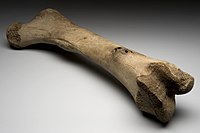
Photo from wikipedia
Bone health problems are a serious threat to laying hens; microbiome-based therapies, which are harmless and inexpensive, may be an effective solution for bone health problems. Here, we examined the… Click to show full abstract
Bone health problems are a serious threat to laying hens; microbiome-based therapies, which are harmless and inexpensive, may be an effective solution for bone health problems. Here, we examined the impacts of supplementation with Clostridium butyricum (CB) on bone and immune homeostasis in pullets. The results of in vivo experiments showed that feeding the pullets CB was beneficial to the development of the tibia and upregulated the levels of the bone formation marker alkaline phosphatase and the marker gene runt-related transcription factor 2 (RUNX2). For the immune system, CB treatment significantly upregulated IL-10 expression and significantly increased the proportion of T regulatory (Treg) cells in the spleen and peripheral blood lymphocytes. In the in vitro test, adding CB culture supernatant or butyrate to the osteoblast culture system showed no significant effects on osteoblast bone formation, while adding lymphocyte culture supernatant significantly promoted bone formation. In addition, culture supernatants supplemented with treated lymphocytes (pretreated with CB culture supernatants) stimulated higher levels of bone formation. In sum, the addition of CB improved bone health by modulating cytokine expression and the ratio of Treg cells in the immune systems of layer pullets. Additionally, in vitro CB could promote the bone formation of laying hen osteoblasts through the mediation of lymphocytes.
Journal Title: International Journal of Molecular Sciences
Year Published: 2023
Link to full text (if available)
Share on Social Media: Sign Up to like & get
recommendations!